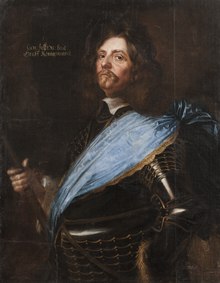Imperial-Saxon army

There are essentially two different orders of battle for the Imperial-Saxon army. The one cited by William Guthrie mostly uses the information from the Theatrum Europaeum. [5] According to Otto Rudert, this order of battle was the intended one but was changed shortly prior to the battle. Rudert and Arndt Preil instead use the Callenbergische Battaglia from the battle report of Colonel Kurt Reinecke von Callenberg. The Battaglia is meant to indicate the actual order of troops in battle and is used in this list. [6] [7]
Overall commanders were Archduke Leopold Wilhelm of Austria and Field-Marshal Ottavio Piccolomini. Unless otherwise noted, all units are German. [8]
Left
Generalfeldwachtmeister Hans Christoph von Puchheim, 31 squadrons [9]
First Echelon (Colonel Nicola Montard de Noyrel) [9]
- Pompeij Cuirassier – Colonel Thomas Pompeji [9] [10] [11]
- Madlo Arquebusier – Colonel Hans Georg Madlo [9] [12] [13]
- Luigi Gonzaga Cuirassier – Major Khauts [14] [15]
- Vorhauer Cuirassier – Colonel Hans Vorhauer [9] [16] [17] [18]
- Wintz Cuirassier – Colonel Christoph von Wintz [9] [19] [18]
- Jung-Heister Cuirassier – Colonel Arnold von Heister [14] [20] [21]
- Alt-Heister Cuirassier – Lieutenant Colonel Andreas Stahl [14] [22] [18]
- Nicola Cuirassier – Lieutenant Colonel Dominik Cadé [7] [9] [23]
- Puchheim Cuirassier – Lieutenant Colonel Candido [6] [7] [24]
Second Echelon (Colonel Schleinitz) [9]
- Burksdorf Cuirassier – Colonel Conrad Burksdorf [6] [9] [25]
- Warlowsky Arquebusier – Colonel Peter Warlowsky [26] [12] [18] [27]
- Krafft zu Lammerstorf Cuirassier [26] – Colonel Heinrich Krafft zu Lammerstorf [28] [29]
- Callenberg Saxon Cuirassier – Colonel Kurt Reinecke von Callenberg [6] [30] [31] [32]
- Gall à Bourck Dragoons – Lieutenant Colonel Olivier Stephanson [33] [6] [34]
- Knoche Saxon Cuirassier – Colonel von Knoche [6] [30] [31]
- Gallas Dragoons – Lieutenant Colonel Johann Ablmont [33] [35]
- Schleinitz Saxon Cuirassier – Colonel von Schleinitz [6] [30] [31]
Flankers
- 8 squadrons of Croats and Cossacks [26]
Center
Feldzeugmeister Ernst Roland von Suys, 11 brigades, 8 squadrons, 46 guns [9]
Left Group (Feldzeugmeister Johann Barwitz von Fernemont and Generalfeldwachtmeister Anton von Weveld) [9] [36]
- Enkevort Infantry – Lieutenant Colonel Michael Thomb [9] [37]
- Weveld Infantry – Lieutenant Colonel Simon Schrenk genannt Notzing [9] [38]
- Caretto di Grana Infantry – Lieutenant Colonel Paolo Pestaluzzi [9] [39] [6] [40]
- Sax-Lauenburg Infantry – Lieutenant Colonel Rohrscheid [14] [6] [41]
- Moncada Infantry – Colonel Matteo Marchese di Moncada y Cardona [9] [6] [42]
Right Group (Generalfeldwachtmeister Camillo Gonzaga) [9]
- Suys Infantry (Walloon) – Lieutenant Colonel Eusebius von Crivelli [9] [43]
- Annibale Gonzaga Infantry – Lieutenant Colonel Valentin Hauser [14] [44]
- Ranfft Infantry – Colonel Johann Christoph Ranfft von Wiesenthal [9] [45] [46]
- Archduke Leib Infantry – Lieutenant Colonel Gustav [14] [47]
- Fernemont Infantry – Lieutenant Colonel Nouskovsky [9] [48]
- Wachenheim Infantry – Colonel Otto Ludwig von Wachenheim [9] [49] [50]
Reserve (Feldzeugmeister Suys) [9]
- Archduke Leib – Colonel Sforza Marchese di Pallavicini [51] [52] [53] [29]
- Piccolomini Leib – Lieutenant Colonel Ghiselieri [51] [54]
- Grodetzky Arquebusier – Colonel Georg Dietrich Grodetzky von Grodetz [9] [55] [56]
- Gissenburg Cuirassier – Colonel Tobias von Gissenburg [9] [57]
- Desfours Cuirassier (Spanish-German) – Colonel Johann von Desfours [9] [58] [59]
- Paconchay Dragoons – Colonel Martin de Paconchay [9] [60]
Right

Feldzeugmeister Annibale Gonzaga, 32 squadrons [51]
First Echelon (Lieutenant Field Marshall Albert Gaston Spinola von Bruay) [51]
- Mislik Cuirassier – Colonel Johann Sigmund von Mislik [7] [51] [61] [62]
- Alt-Piccolomini Cuirassier – Lieutenant Colonel Georg von Crespu [7] [51] [63] [64] [29]
- Bruay Cuirassier – Lieutenant Colonel Claus von Paumgarten [7] [51] [65]
- Jung Cuirassier – Colonel Gottfried von Jung [66] [6]
- Montecuccoli Cuirassier – Lieutenant Colonel Claudius Franz von Lannoy [67] [7] [68]
- Sperreuter Cuirassier – Lieutenant Colonel Johann Walter [67] [7] [69]
- Neu-Piccolomini Cuirassier– Colonel Paul Béchamp [51] [70] [71]
- La Corona Dragoons – Colonel Johann de la Corona [7] [72]
Second Echelon (Generalfeldwachtmeister Jacob Borneval d’Arlin) [51]
- Spiegel Cuirassier – Lieutenant Colonel Lützelburg [67] [7] [73]
- Lüttke Cuirassier – Colonel Moriz von der Lüttke [7] [51] [74]
- Wolframsdorf Cuirassier – Colonel Rudolph Georg von Wolframsdorf [7] [51] [75]
- Kapaun Cuirassier – Colonel Albrecht Weikhard Kapaun von Swoykow [7] [51] [76]
- Hanau Saxon Cuirassier [7] – Generalfeldwachtmeister Augustin von Hanau [31] [77]
- Borneval Cuirassier – Lieutenant Colonel Dohna [7] [9] [78]
- Munster Arquebusier – Colonel Christian von Münster [7] [9] [55] [79]
Flankers
- 8 squadrons of Croats and Cossacks [9]

















